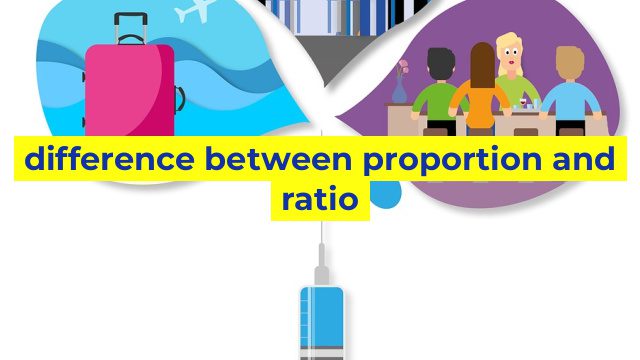The Difference Between Proportion and Ratio: Understanding Mathematical Concepts
Mathematicians use a lot of terms that can be confusing and difficult to understand. Two such terms are proportion and ratio, which are often used interchangeably, but they have different meanings. Understanding the distinction between proportion and ratio is essential to solving mathematical problems and communicating effectively with others about mathematical concepts.
What is a Ratio?
A ratio is a comparison of two quantities by division. It is written as a fraction or a colon. For example, suppose you have a pizza with eight slices, and you eat four of them. The ratio of slices you ate to the total number of slices is 4:8 or 4/8, which can be simplified to 1:2 or 1/2.
When solving problems involving ratios, it’s essential to keep in mind that the order of items in a ratio is essential. For example, the ratio of the width to the length of a rectangle is not the same as the ratio of the length to the width.
What is a Proportion?
A proportion is like a ratio, but with an added element of equality. It’s an equation that shows that two ratios are equivalent. For instance, if you have two ratios, 1:2 and 2:4, you can write them as a proportion:
1:2 = 2:4
When you solve problems involving proportions, you’re asked to find an unknown number or variable that is part of the ratio. You can solve for the variable through cross-multiplication or substitution.
Key Differences Between Proportion and Ratio
The key difference between proportion and ratio is that the proportion involves the equality of two ratios. A ratio is simply a comparison of two quantities by division. Additionally, in a ratio, the order of the items matters, and if you switch the order, the ratio changes. In a proportion, the order of items is not significant.
Another difference is in the way these concepts are used to solve problems. Ratios are useful when we are comparing two things, and we want to know the relative size of one thing compared to another. Proportions are used to find the missing quantities within a ratio and help to develop a deeper understanding of the relationship between two ratios.
Conclusion
In conclusion, understanding the difference between proportion and ratio is crucial to developing a sound foundation in mathematics. While the two terms are similar, they have distinct meanings and are used for different purposes. A ratio is a comparison of two quantities by division, while a proportion is a statement that two ratios are equal. Being clear about these concepts will help you solve mathematical problems more accurately and effectively.
Table difference between proportion and ratio
| Proportion | Ratio |
|---|---|
| A comparison of two or more parts to the whole. | A comparison of two or more quantities of the same kind. |
| Represents the relationship between the part and the whole. | Represents the relationship between two quantities of the same kind. |
| Expressed in the form of a fraction, percentage, or decimal. | Expressed in the form of a fraction, ratio or decimal. |
| Used to compare the proportion of one part of a whole to another part. | Used to compare the quantity of one thing to another thing of the same unit. |
| Example: The proportion of apples to oranges in a basket is 2:1. | Example: The ratio of boys to girls in a class is 2:3. |

